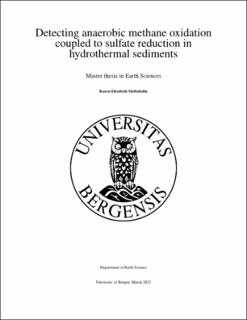| dc.contributor.author | Moltubakk, Karen Elisabeth | |
| dc.date.accessioned | 2022-04-05T23:43:23Z | |
| dc.date.available | 2022-04-05T23:43:23Z | |
| dc.date.issued | 2022-03-07 | |
| dc.date.submitted | 2022-04-05T22:00:05Z | |
| dc.identifier.uri | https://hdl.handle.net/11250/2990016 | |
| dc.description.abstract | The barite field is a low-temperature vent field, characterized by microbial activity and high fluid values of $NH_4$, $SO_4^{2-}$, and $CH_4$. Geochemical analysis indicates a hydrothermal system with a sedimentary input from the Bear Island Fan that has affected the high-temperature fluids. The diluted version of the high-temperature fluids mixes with a seawater input in the barite field. The mixture intensifies the $CH_4$ (4nM) production, and when meeting with $SO_4^{2-}$ (28.29 $\mu M$) produces high values of $H_2S$ (15.71$\mu M$). The barite field offers a unique opportunity to study the AOM-SR in hydrothermal sediments with high production of $CH_4$ and high concentration of seawater $SO_4^{2-}$ circulation the sediments, and the temperature (20$\celsius$) makes it habitable for microorganisms to thrive. The microbial mats consume the oxygen available on the surface sediments; barely any oxygen enters the top sediments, making the sediments in the barite field suboxic and anoxic. The anoxic environment is perfect for the anaerobic methanotrophic archaea ANME since oxygen is toxic for the ANIME. One gravity core and one blade core were sampled in 2014 and 2018, respectively. The SEM pictures display high abundances of framboidal pyrite from the blade core and pyrite octahedrons in the gravity core. The geochemistry from the barite field shows fluctuating $CH_4$, TOC, and $H_2S$ values indicating that AOM-SR can occur in several sediment horizons. The $SO_4^{2-}$ concentration remains stable through the sediment core, indicating a potential flux of $SO_4^{2-}$ to the sediments. The sulfur isotopes indicate a biogenic origin of the isotopes related to the sediment core. Different sulfate reduction rates lead to more positive values in the blade core with the highest rates. The iron isotopes present a wide range of values from negative to positive for both cores. They indicate an iron limitation in several of the sediment horizons and, for the first time, identify AOM-SR in hydrothermal sediments. | |
| dc.language.iso | nob | |
| dc.publisher | The University of Bergen | |
| dc.rights | Copyright the Author. All rights reserved | |
| dc.subject | microorganisms | |
| dc.subject | sulfur isotopes | |
| dc.subject | geochemistry | |
| dc.subject | iron isotope | |
| dc.subject | pyrite | |
| dc.subject | AOM-SR | |
| dc.subject | paleo-AOM | |
| dc.title | Detecting anaerobic methane oxidation coupled to sulfate reduction in hydrothermal sediments | |
| dc.title.alternative | Detecting anaerobic methane oxidation coupled to sulfate reduction in hydrothermal sediments | |
| dc.type | Master thesis | |
| dc.date.updated | 2022-04-05T22:00:05Z | |
| dc.rights.holder | Copyright the Author. All rights reserved | |
| dc.description.degree | Masteroppgave i geovitenskap | |
| dc.description.localcode | GEOV399 | |
| dc.description.localcode | MAMN-GEOV | |
| dc.subject.nus | 756199 | |
| fs.subjectcode | GEOV399 | |
| fs.unitcode | 12-50-0 | |
